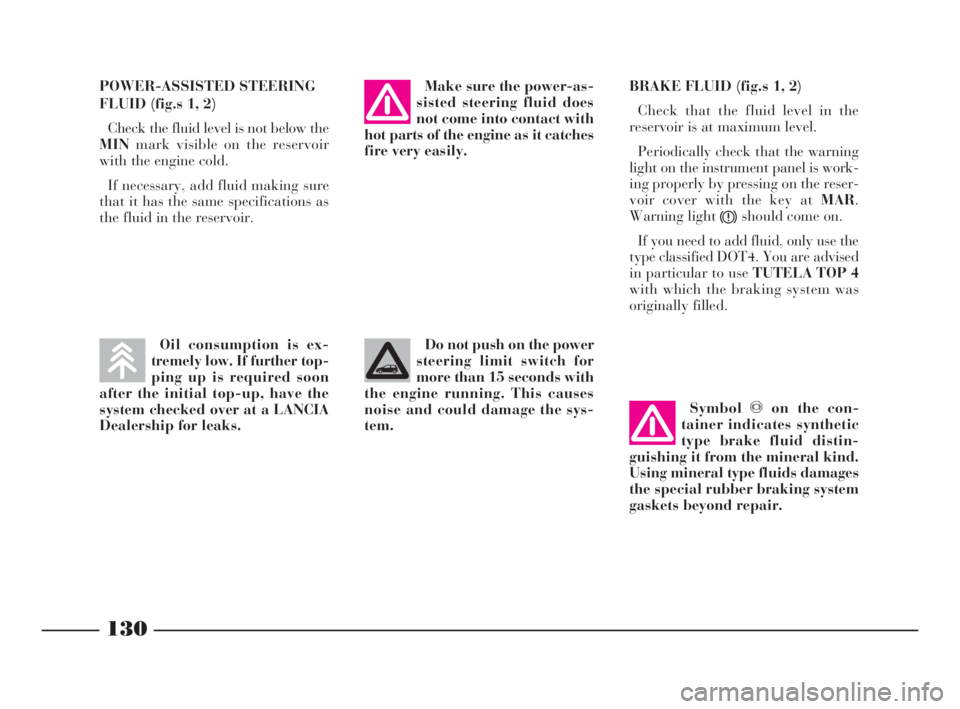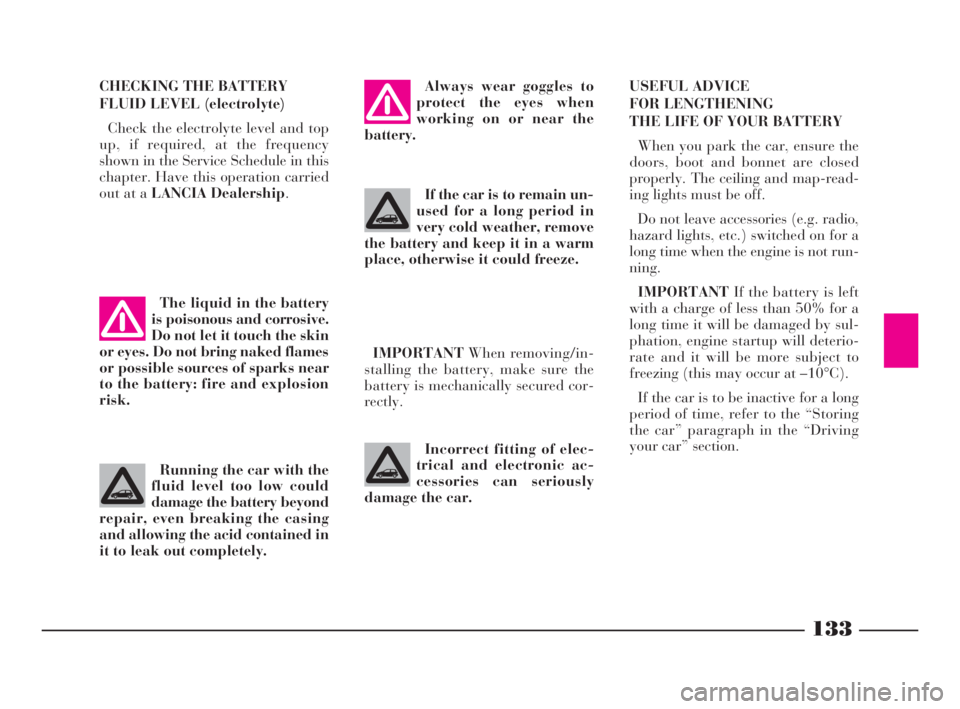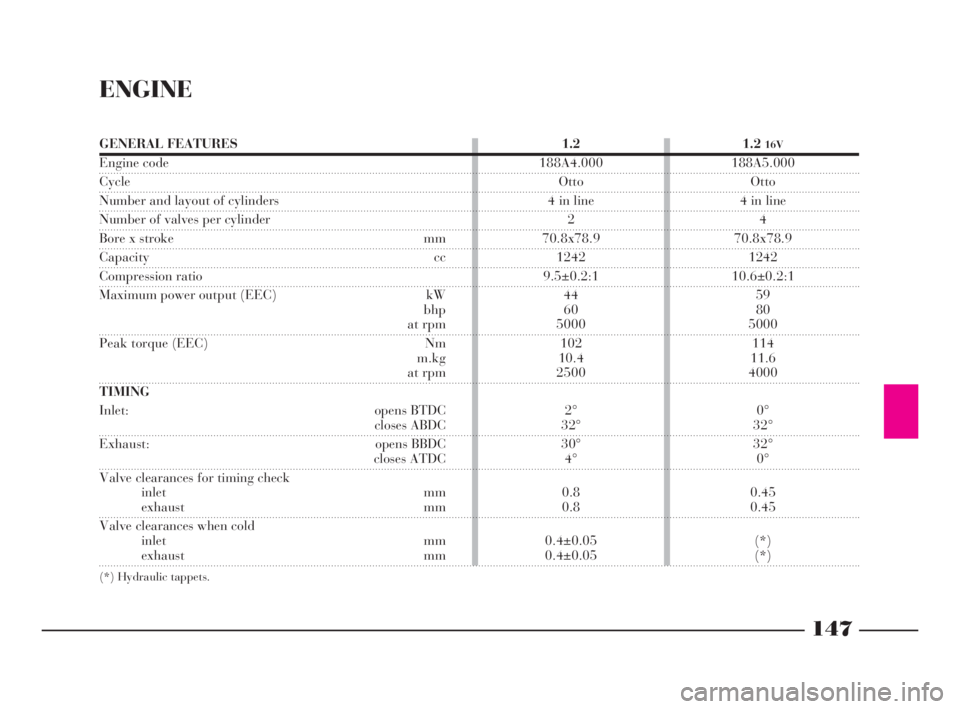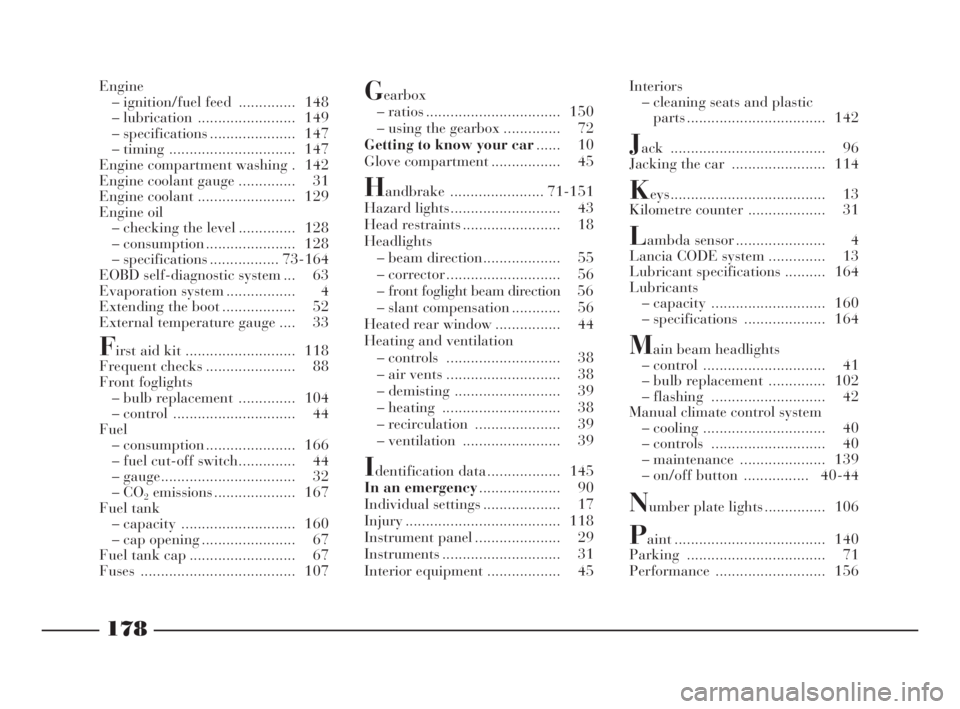check engine Lancia Ypsilon 2001 Owner handbook (in English)
[x] Cancel search | Manufacturer: LANCIA, Model Year: 2001, Model line: Ypsilon, Model: Lancia Ypsilon 2001Pages: 191, PDF Size: 2.45 MB
Page 133 of 191

130
G
POWER-ASSISTED STEERING
FLUID (fig.s 1, 2)
Check the fluid level is not below the
MINmark visible on the reservoir
with the engine cold.
If necessary, add fluid making sure
that it has the same specifications as
the fluid in the reservoir.BRAKE FLUID (fig.s 1, 2)
Check that the fluid level in the
reservoir is at maximum level.
Periodically check that the warning
light on the instrument panel is work-
ing properly by pressing on the reser-
voir cover with the key at MAR.
Warning light
xshould come on.
If you need to add fluid, only use the
type classified DOT4. You are advised
in particular to use TUTELA TOP 4
with which the braking system was
originally filled.
Symbolπon the con-
tainer indicates synthetic
type brake fluid distin-
guishing it from the mineral kind.
Using mineral type fluids damages
the special rubber braking system
gaskets beyond repair.
Make sure the power-as-
sisted steering fluid does
not come into contact with
hot parts of the engine as it catches
fire very easily.
Do not push on the power
steering limit switch for
more than 15 seconds with
the engine running. This causes
noise and could damage the sys-
tem.Oil consumption is ex-
tremely low. If further top-
ping up is required soon
after the initial top-up, have the
system checked over at a LANCIA
Dealership for leaks.
4C120-143 ING 11-03-2008 12:01 Pagina 130
Page 136 of 191

133
G
USEFUL ADVICE
FOR LENGTHENING
THE LIFE OF YOUR BATTERY
When you park the car, ensure the
doors, boot and bonnet are closed
properly. The ceiling and map-read-
ing lights must be off.
Do not leave accessories (e.g. radio,
hazard lights, etc.) switched on for a
long time when the engine is not run-
ning.
IMPORTANTIf the battery is left
with a charge of less than 50% for a
long time it will be damaged by sul-
phation, engine startup will deterio-
rate and it will be more subject to
freezing (this may occur at –10°C).
If the car is to be inactive for a long
period of time, refer to the “Storing
the car” paragraph in the “Driving
your car” section.
The liquid in the battery
is poisonous and corrosive.
Do not let it touch the skin
or eyes. Do not bring naked flames
or possible sources of sparks near
to the battery: fire and explosion
risk.
Incorrect fitting of elec-
trical and electronic ac-
cessories can seriously
damage the car.
IMPORTANTWhen removing/in-
stalling the battery, make sure the
battery is mechanically secured cor-
rectly.
Running the car with the
fluid level too low could
damage the battery beyond
repair, even breaking the casing
and allowing the acid contained in
it to leak out completely.
Always wear goggles to
protect the eyes when
working on or near the
battery.
If the car is to remain un-
used for a long period in
very cold weather, remove
the battery and keep it in a warm
place, otherwise it could freeze.
CHECKING THE BATTERY
FLUID LEVEL (electrolyte)
Check the electrolyte level and top
up, if required, at the frequency
shown in the Service Schedule in this
chapter. Have this operation carried
out at a LANCIA Dealership.
4C120-143 ING 11-03-2008 12:01 Pagina 133
Page 137 of 191

134
G
If, after purchasing the vehicle you
want to install electrical accessories
that require a permanent power sup-
ply (alarm, free-hand phone, radio
navigator with satellite anti theft sys-
tem, etc.) go to a LANCIA Dealer-
ship. The qualified staff are able to
suggest the most suitable Lineacces-
sori devices and will assess the over-
all electric absorption, checking
whether the car can sustain the re-
quired load or if an oversized battery
is required.
Remember that these accessories
continue to absorb electrical power
even when the ignition key is removed
(car parked, engine off) and could
discharge the battery.The overall absorption of these ac-
cessories (standard and after-sale in-
stallations) must be less than 0.6 mA
x Ah (of the battery) as shown in the
table below:ELECTRONIC
CONTROL UNITS
When the car is being used nor-
mally, special measures are not nec-
essary.
The following instructions must be
followed very carefully, however, if
you work on the electrical system or
in cases where emergency starting is
necessary:
– Never disconnect the battery from
the electrical system while the engine
is running.
– Disconnect the battery from the
electrical system if you are recharging
it. Modern battery chargers can sup-
ply up to 20 volts.
– Never perform emergency starts
with a battery charger. Always use an
auxiliary battery.
– Be particularly careful when con-
necting the battery to the electrical sys-
tem. Ensure the battery posts are con-
nected up to the right leads (the polar-
ity is correct) and check that the con-
nection has been made properly. When Remember also that high current in-
take devices such as bottle heater,
vacuum cleaner, cellular phone, re-
frigerator etc., if powered while the
engine is off will accelerate the bat-
tery discharge.
IMPORTANTIf you need to install
additional systems on the car, im-
proper wiring connections, in partic-
ular if they affect safety devices, are
dangerous.
Battery Maximum
capacity idle
intake
40 Ah 24 mA
4C120-143 ING 11-03-2008 12:01 Pagina 134
Page 138 of 191

135
G
SPARK PLUGS
The cleanness and soundness of the
spark plugs are very important for
keeping the engine efficient and pol-
luting emissions down.
The appearance of the spark plug
(fig. 6), if examined by an expert eye,
is a good way of pinpointing a mal-
function even if it has nothing to do
with the ignition system. Therefore if
the engine has problems, it is impor-
tant to have the spark plugs checked
at a LANCIA Dealership.The spark plugs must be
changed at the times spec-
ified in the Service Sched-
ule. Only use the type of plugs in-
dicated: if the heat ratio is less
than required or the life specified
is not guaranteed, problems can
arise.
the battery is reconnected, the injec-
tion/ignition system control unit must
readapt its internal parameters; conse-
quently performance may not be opti-
mal during the first few kilometres af-
ter reconnecting the battery.
– Do not connect or disconnect the
terminals of the electronic units while
the ignition key is at MAR.
– Do not check polarity through
sparking.
– Disconnect the electronic units if
you are electrically welding the car
body. Remove the units if tempera-
tures exceed 80°C (special operations
on the bodywork etc.).
IMPORTANTIf the radio or car
alarm systems are not installed cor-
rectly, they can interfere with the
working of the electronic control units.
Modifications or repairs
to the electrical system
that are performed incor-
rectly and do not take into account
the system’s technical features can
result in malfunctions with the
risk of fire.
Versions Type of spark plug
1.2ChampionRC10YCC
NKG BKR5EZ
1.216VNGK DCPR8E-N
fig. 6
P4C00308
4C120-143 ING 11-03-2008 12:01 Pagina 135
Page 145 of 191

Detergents pollute water.
The car must therefore be
washed in an area
equipped for the collection and
purification of the liquids used
while washing.
IMPORTANTThe car should be
washed while the engine is cold and
with the ignition key at STOP. After
washing the car, make sure that the
various protections (e.g. rubber boots
and various guards) have not been re-
moved or damaged.
142
G
Windows
Use specific window cleaners to
clean the windows. Use very clean
cloths to avoid scratching the glass or
damaging its transparency.
IMPORTANTTo prevent damage
to the electric heater elements, wipe
the inside of the heated rear window
gently in the same direction as the el-
ements.
Engine compartment
At the end of each winter season,
carefully clean the engine compart-
ment. Be careful not to direct the jet
of water on the electronic control
units. Have this done at a garage.INTERIORS
From time to time check that water
has not collected under the mats
(from dripping shoes, umbrellas etc.)
which could cause the steel to rust.
CLEANING THE SEATS
AND FABRIC UPHOLSTERY
– Remove the dust with a soft brush
or a vacuum cleaner.
– Rub the seats with a sponge moist-
ened in a solution of water and neu-
tral detergent.
4C120-143 ING 11-03-2008 12:01 Pagina 142
Page 150 of 191

147
G
ENGINE
GENERAL FEATURES
Engine code
Cycle
Number and layout of cylinders
Number of valves per cylinder
Bore x stroke mm
Capacity cc
Compression ratio
Maximum power output (EEC) kW
bhp
at rpm
Peak torque (EEC) Nm
m.kg
at rpm
TIMING
Inlet: opens BTDC
closes ABDC
Exhaust: opens BBDC
closes ATDC
Valve clearances for timing check
inlet mm
exhaust mm
Valve clearances when cold
inlet mm
exhaust mm1.2
188A4.000
Otto
4 in line
2
70.8x78.9
1242
9.5±0.2:1
44
60
5000
102
10.4
2500
2°
32°
30°
4°
0.8
0.8
0.4±0.05
0.4±0.051.2
16V
188A5.000
Otto
4 in line
4
70.8x78.9
1242
10.6±0.2:1
59
80
5000
114
11.6
4000
0°
32°
32°
0°
0.45
0.45
(*)
(*)
(*) Hydraulic tappets.
4C144-167 ING 11-03-2008 12:02 Pagina 147
Page 180 of 191

177
fdG
INDEX
ABS ...................................... 56
Accessories purchased
by the user ........................... 88
Accessory installation........... 168
Accident .................................. 117
Air cleaner............................... 131
Air recirculation ...................... 39
Air vents.................................. 38
Airbags (front and side) .......... 58
– passenger airbag manual
deactivation ....................... 59
– warnings............................ 61
Alternator ............................... 155
Ashtray .................................. 46
Battery
– jump starting .................... 92
– fluid level ......................... 133
– recharging ........................ 113
– replacement ....................... 132
– specifications ..................... 155
Bodywork
– maintenance ..................... 140
– paint identification plate.... 146
– versions ............................. 146
Bonnet..................................... 53
Boot
– extending........................... 52– opening/closing ................. 51
– replacing a bulb................. 107
Boot light ................................ 107
Brake fluid .............................. 130
Brake lights ............................. 105
Brakes
– fluid level ......................... 130
– service and emergency ....... 151
Bulb replacement ................ 74-99
Capacities ...................... 73-160
Car maintenance................... 120
– additional checks .............. 124
– annual inspection schedule . 124
– bodywork maintenance ..... 140
– scheduled service ............... 121
– service schedule ................. 122
Catalytic converter (three-way) . 4
Ceiling light ........................ 45-46
– bulb replacement .............. 106
Cellular telephone setup system 66
Cellular telephones .............. 66-88
Centralised door locking system 49
Cheap running ....................... 83
Checking fluid levels .............. 127
Cigar lighter ........................... 46
Clock ...................................... 32
Clutch ..................................... 150
CO
2emissions in exhaust ......... 167
Containing running costs and
pollution............................... 81Control buttons ....................... 44
Dashboard ............................ 11
Demisting
– electrical mirrors ........... 20-39
– rear window ...................... 39
– windscreen and side
windows ............................ 39
Differential ............................. 151
Dimensions ............................. 158
Dipped beam headlights
– bulb replacement .............. 102
– control .............................. 41
Direction indicators
– control .............................. 42
– front bulb replacement ..... 103
– rear bulb replacement ....... 104
– side bulb replacement ........ 103
Doors ...................................... 49
Driving your car.................... 68
EBD electronic brake force
distributor ........................ 35-58
Electric window winders.......... 50
Electronic control unit ............. 134
Engine
– cooling .............................. 149
– identification code ............. 146
4C177-184 Indice ING 13-03-2008 13:31 Pagina 177
Page 181 of 191

178
fdG
Interiors
– cleaning seats and plastic
parts .................................. 142
Jack ...................................... 96
Jacking the car ....................... 114
Keys...................................... 13
Kilometre counter ................... 31
Lambda sensor ...................... 4
Lancia CODE system .............. 13
Lubricant specifications .......... 164
Lubricants
– capacity ............................ 160
– specifications .................... 164
Main beam headlights
– control .............................. 41
– bulb replacement .............. 102
– flashing ............................ 42
Manual climate control system
– cooling .............................. 40
– controls ............................ 40
– maintenance ..................... 139
– on/off button ................ 40-44
Number plate lights ............... 106
Paint ..................................... 140
Parking .................................. 71
Performance ........................... 156 Engine
– ignition/fuel feed .............. 148
– lubrication ........................ 149
– specifications ..................... 147
– timing ............................... 147
Engine compartment washing . 142
Engine coolant gauge .............. 31
Engine coolant ........................ 129
Engine oil
– checking the level .............. 128
– consumption ...................... 128
– specifications ................. 73-164
EOBD self-diagnostic system ... 63
Evaporation system ................. 4
Extending the boot .................. 52
External temperature gauge .... 33
First aid kit ........................... 118
Frequent checks ...................... 88
Front foglights
– bulb replacement .............. 104
– control .............................. 44
Fuel
– consumption ...................... 166
– fuel cut-off switch.............. 44
– gauge................................. 32
–CO
2emissions .................... 167
Fuel tank
– capacity ............................ 160
– cap opening ....................... 67
Fuel tank cap .......................... 67
Fuses ...................................... 107
Gearbox
– ratios ................................. 150
– using the gearbox .............. 72
Getting to know your car...... 10
Glove compartment ................. 45
Handbrake ....................... 71-151
Hazard lights........................... 43
Head restraints ........................ 18
Headlights
– beam direction................... 55
– corrector ............................ 56
– front foglight beam direction 56
– slant compensation ............ 56
Heated rear window ................ 44
Heating and ventilation
– controls ............................ 38
– air vents ............................ 38
– demisting .......................... 39
– heating ............................. 38
– recirculation ..................... 39
– ventilation ........................ 39
Identification data .................. 145
In an emergency.................... 90
Individual settings ................... 17
Injury ...................................... 118
Instrument panel ..................... 29
Instruments ............................. 31
Interior equipment .................. 45
4C177-184 Indice ING 13-03-2008 13:31 Pagina 178